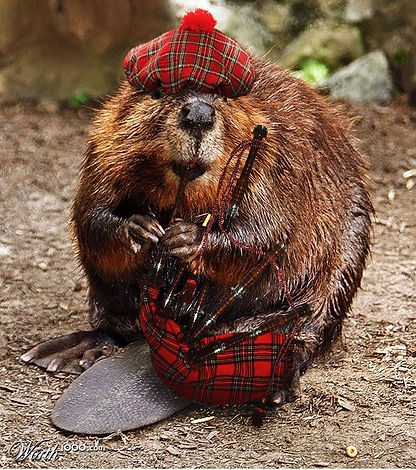




WELCOME TO An Entertainment Site for Scottish Country Dancers - Enjoy the curated selection of theme-related dances for celebrations and holidays, or find a dance associated with a special calendar day, or EVEN your own birthday!
Beaver Day
Apr 7
Other Scottish Country Dances for this Day
Today's Musings, History & Folklore
"It must be very easy for the busy Beaver mother
To feed the Beaver sister and her little Beaver brother,
For when they beg: "We're hungry, give us something to eat, please!"
She sends them off to nibble at the bark of the big trees."
~ Animal Children, Edith Brown Kirkwood, 1913
Beavertail slaps are believed to serve as alarm signals warning other beavers of a potential threat. An adult's tail slap is more successful in alerting others, which then escape into the beaver's lodge house of sticks or deeper water. This reel is structured around a story of beavers and their warning slaps! As the dance-story begins, beavers are cutting down a very large tree (petronella setting and turning). When the tree finally falls, two beavers are started and slap their tails against the water in alarm (a clap) and swim around in panic. Hearing the alrm, the other beaers slap their tails on the water (all clap) and swim seeing a safe place (reels of three). The industrious beaver figures prominently in folklore, particular that of the Native Americans. In the Ojibwa legend, "How the Beaver got its Tail," a beaver visits a series of animals in the forest to show off his big round fluffy tail, of which he is very proud. When he realizes that no one is impressed, he begins to gnaw down trees in pure frustration, until a tree falls and squashes his tail. The Creator sees his tears of sorrow for his ruined tail but comforts him by saying "A beaver isn’t liked for its tail, but for its kindness and wisdom. And now you can swim better and signal to your family by slapping your tail on the water!” Petronella and slap those tails! 🦫 🦫 🦫
The Beavertail Slap
April 7 is known as International Beaver Day commemorating the birthday of Dorothy Richards (1894-1985), a woman who studied beavers for almost 50 years at the Beaversprite Sanctuary in the Adirondack Mountains of New York and whose work inspired the the nonprofit group Beavers: Wetlands & Wildlife.
The beaver is known in Gaelic as dobhran losleathan, meaning ‘broad-tailed otter’ and is seen in the crest for Clan Beveridge.
Almost hunted to extinction in the 18th century, it is now making a comeback in Scotland.
In times past, people prized the beaver for its meat, fur, and also for castoreum, an oily substance produced by glands beneath its tail.
Humans have used the beaver’s thick waterproof fur for thousands of years.
The presence of beavers in Britain is still echoed in a number of place-names. Examples include Beverley in Yorkshire, meaning beaver’s stream.
Canada’s national animal, the Canadian beaver is a different species to the European beaver. It is far more industrious in its damming activities, giving rise to the popular term ‘eager beaver’.
Beavers feature a lot in Native American folklore, fossils show that during the last Ice Age a giant species of beaver the size of a bear dwelled in North America.
In the dance, written by Carolyn Engel-Wilson of Phoenix Branch, Arizona (based on an idea from her non-dancer husband Ron), the dance tells a story about beavers. When the story begins, the beavers are cutting down a very large tree (petronella setting and turning). When the tree finally falls, two beavers are so startled by the crash that they slap their flat tails on the water in alarm (the clap) and swim around in panic. Hearing the tails slap and seeing the frantic activity alarms the other beavers in the pond. They all slap their tails on the water (all clap) and swim around seeking a safe place (reels of three).
For more about the Beaver, click the the furred member of Clan Beaver!
Click the dance cribs or description below to link to a printable version of the dance!



